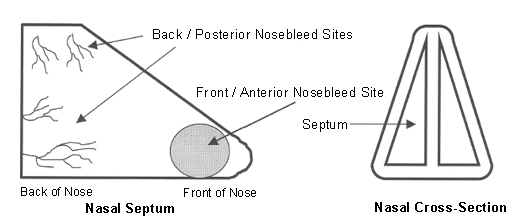Provide information about packing including the type of packing used, potential complications, the plan for removing the packing, care after pack removal, and indications for urgent reassessment.[8]Tunkel DE, Anne S, Payne SC, et al. Clinical practice guideline: nosebleed (epistaxis). Otolaryngol Head Neck Surg. 2020 Jan;162(1 suppl):S1-S38.
https://doi.org/10.1177%2F0194599819890327
http://www.ncbi.nlm.nih.gov/pubmed/31910111?tool=bestpractice.com
Potential complications include local or very rarely, systemic infection, septal perforation, scar bands, pressure sores on the skin, and sleep apnea.[8]Tunkel DE, Anne S, Payne SC, et al. Clinical practice guideline: nosebleed (epistaxis). Otolaryngol Head Neck Surg. 2020 Jan;162(1 suppl):S1-S38.
https://doi.org/10.1177%2F0194599819890327
http://www.ncbi.nlm.nih.gov/pubmed/31910111?tool=bestpractice.com
Advise patients that nonresorbable packing will need to be removed by a clinician, and that although resorbable packing should not need to be removed, follow-up to ensure complete resorption and mucosal healing is recommended.[8]Tunkel DE, Anne S, Payne SC, et al. Clinical practice guideline: nosebleed (epistaxis). Otolaryngol Head Neck Surg. 2020 Jan;162(1 suppl):S1-S38.
https://doi.org/10.1177%2F0194599819890327
http://www.ncbi.nlm.nih.gov/pubmed/31910111?tool=bestpractice.com
Reassure patients that symptoms similar to a cold including nasal obstruction, decreased sense of smell, pressure, headaches, nasal discharge, and tearing from the eyes are expected.[8]Tunkel DE, Anne S, Payne SC, et al. Clinical practice guideline: nosebleed (epistaxis). Otolaryngol Head Neck Surg. 2020 Jan;162(1 suppl):S1-S38.
https://doi.org/10.1177%2F0194599819890327
http://www.ncbi.nlm.nih.gov/pubmed/31910111?tool=bestpractice.com
Tell them that if a bleed occurs while packing is in place they should immediately return to the emergency department while pinching their nose.[8]Tunkel DE, Anne S, Payne SC, et al. Clinical practice guideline: nosebleed (epistaxis). Otolaryngol Head Neck Surg. 2020 Jan;162(1 suppl):S1-S38.
https://doi.org/10.1177%2F0194599819890327
http://www.ncbi.nlm.nih.gov/pubmed/31910111?tool=bestpractice.com
They should also call their doctor urgently if they develop a fever over 101ºF (38.3ºC) or a diffuse skin rash, experience increasing pain, shortness of breath, facial swelling, vision changes, or loss of color around the skin of the nose.[8]Tunkel DE, Anne S, Payne SC, et al. Clinical practice guideline: nosebleed (epistaxis). Otolaryngol Head Neck Surg. 2020 Jan;162(1 suppl):S1-S38.
https://doi.org/10.1177%2F0194599819890327
http://www.ncbi.nlm.nih.gov/pubmed/31910111?tool=bestpractice.com
Advise patients to use aggressive prophylactic moisturization during dry, cold months to reduce the frequency of epistaxis in patients with a history of this problem.
Give patients and their caregivers information about preventive measures, home treatment, and indications to seek medical care.[8]Tunkel DE, Anne S, Payne SC, et al. Clinical practice guideline: nosebleed (epistaxis). Otolaryngol Head Neck Surg. 2020 Jan;162(1 suppl):S1-S38.
https://doi.org/10.1177%2F0194599819890327
http://www.ncbi.nlm.nih.gov/pubmed/31910111?tool=bestpractice.com
Typical information on printed handouts includes:
Details on the causes of nosebleeds
Basic nasal anatomy, showing that most nosebleeds arise from the front of the nose
Advice on home treatment of nosebleed: squeeze the nostrils together while sitting upright and slightly forward for 15 minutes, then use moisturizing techniques[8]Tunkel DE, Anne S, Payne SC, et al. Clinical practice guideline: nosebleed (epistaxis). Otolaryngol Head Neck Surg. 2020 Jan;162(1 suppl):S1-S38.
https://doi.org/10.1177%2F0194599819890327
http://www.ncbi.nlm.nih.gov/pubmed/31910111?tool=bestpractice.com
A summary of the medical treatment of nosebleeds
Advice concerning care for the nose after treatment. [Figure caption and citation for the preceding image starts]: Diagram of bleeding sites in nose to accompany written patient informationProduced by David A. Randall, Springfield Ear Nose Throat and Facial Plastic Surgery, MO [Citation ends].
Advice on care for the nose following treatment includes the following:
Petroleum jelly: may be applied to the front of the septum, inside the nostril, with a cotton-tipped applicator or a finger, 4 times daily for about 3 weeks.[8]Tunkel DE, Anne S, Payne SC, et al. Clinical practice guideline: nosebleed (epistaxis). Otolaryngol Head Neck Surg. 2020 Jan;162(1 suppl):S1-S38.
https://doi.org/10.1177%2F0194599819890327
http://www.ncbi.nlm.nih.gov/pubmed/31910111?tool=bestpractice.com
Saltwater nasal spray: may be purchased in pharmacies or similar stores and sprayed into the nose 1-3 times a day to keep it moist.[8]Tunkel DE, Anne S, Payne SC, et al. Clinical practice guideline: nosebleed (epistaxis). Otolaryngol Head Neck Surg. 2020 Jan;162(1 suppl):S1-S38.
https://doi.org/10.1177%2F0194599819890327
http://www.ncbi.nlm.nih.gov/pubmed/31910111?tool=bestpractice.com
Humidifier: placing a humidifier near the bed helps to prevent drying at night.[8]Tunkel DE, Anne S, Payne SC, et al. Clinical practice guideline: nosebleed (epistaxis). Otolaryngol Head Neck Surg. 2020 Jan;162(1 suppl):S1-S38.
https://doi.org/10.1177%2F0194599819890327
http://www.ncbi.nlm.nih.gov/pubmed/31910111?tool=bestpractice.com
Minor bleeding: may be expected, especially initially after removal of packing and during the initial healing period; patients may self-treat with pressure and topical decongestants.[8]Tunkel DE, Anne S, Payne SC, et al. Clinical practice guideline: nosebleed (epistaxis). Otolaryngol Head Neck Surg. 2020 Jan;162(1 suppl):S1-S38.
https://doi.org/10.1177%2F0194599819890327
http://www.ncbi.nlm.nih.gov/pubmed/31910111?tool=bestpractice.com
Nasal decongestant spray (e.g., oxymetazoline or phenylephrine): after blowing the nose to clear clots, a nasal decongestant can be sprayed twice into the bleeding nostril, with continued pinching of the nose. Alternatively, the decongestant may be sprayed on to a small cotton wool ball and placed on the bleeding area for 10 to 15 minutes, if bleeding recurs at the front of the nose.[8]Tunkel DE, Anne S, Payne SC, et al. Clinical practice guideline: nosebleed (epistaxis). Otolaryngol Head Neck Surg. 2020 Jan;162(1 suppl):S1-S38.
https://doi.org/10.1177%2F0194599819890327
http://www.ncbi.nlm.nih.gov/pubmed/31910111?tool=bestpractice.com
This may be repeated once.[8]Tunkel DE, Anne S, Payne SC, et al. Clinical practice guideline: nosebleed (epistaxis). Otolaryngol Head Neck Surg. 2020 Jan;162(1 suppl):S1-S38.
https://doi.org/10.1177%2F0194599819890327
http://www.ncbi.nlm.nih.gov/pubmed/31910111?tool=bestpractice.com
Avoidance of aspirin or nonsteroidal anti-inflammatory drugs and other anticoagulant medications: for 3 to 4 weeks as medically appropriate.[8]Tunkel DE, Anne S, Payne SC, et al. Clinical practice guideline: nosebleed (epistaxis). Otolaryngol Head Neck Surg. 2020 Jan;162(1 suppl):S1-S38.
https://doi.org/10.1177%2F0194599819890327
http://www.ncbi.nlm.nih.gov/pubmed/31910111?tool=bestpractice.com
Trauma: avoidance of vigorous nose blowing, rubbing, or picking during healing.
Avoidance of strenuous activity, heavy lifting, or tissues in the nose for at least a week.[8]Tunkel DE, Anne S, Payne SC, et al. Clinical practice guideline: nosebleed (epistaxis). Otolaryngol Head Neck Surg. 2020 Jan;162(1 suppl):S1-S38.
https://doi.org/10.1177%2F0194599819890327
http://www.ncbi.nlm.nih.gov/pubmed/31910111?tool=bestpractice.com
Allergy: if the nosebleed is related to allergy, it is important to treat this.
Follow-up: recommended on an as-needed basis only, so long as there are no continued problems.
If epistaxis does not stop following nasal pressure and nasal decongestant treatment, the patient should call a medical professional. If the bleeding is severe, or the patient feels weak or dizzy, they should call 911 or go to an emergency department.[8]Tunkel DE, Anne S, Payne SC, et al. Clinical practice guideline: nosebleed (epistaxis). Otolaryngol Head Neck Surg. 2020 Jan;162(1 suppl):S1-S38.
https://doi.org/10.1177%2F0194599819890327
http://www.ncbi.nlm.nih.gov/pubmed/31910111?tool=bestpractice.com
Encourage patients to keep the information available for future reference.
